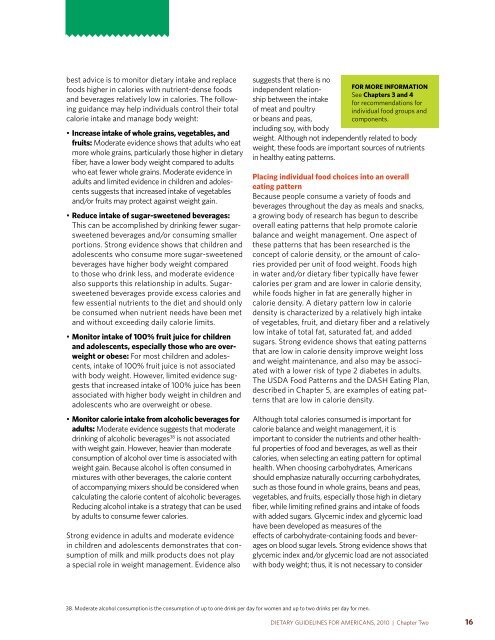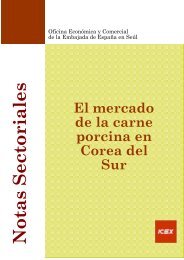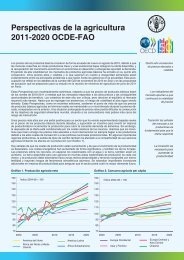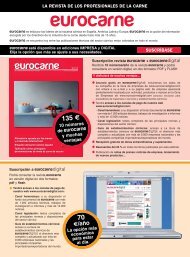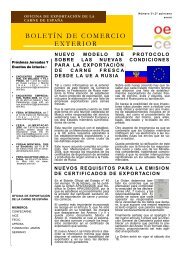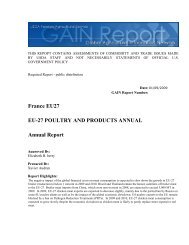Dietary Guidelines for Americans - SchoolNutritionAndFitness.com
Dietary Guidelines for Americans - SchoolNutritionAndFitness.com
Dietary Guidelines for Americans - SchoolNutritionAndFitness.com
- No tags were found...
You also want an ePaper? Increase the reach of your titles
YUMPU automatically turns print PDFs into web optimized ePapers that Google loves.
est advice is to monitor dietary intake and replacefoods higher in calories with nutrient-dense foodsand beverages relatively low in calories. The followingguidance may help individuals control their totalcalorie intake and manage body weight:• increase intake of whole grains, vegetables, andfruits: Moderate evidence shows that adults who eatmore whole grains, particularly those higher in dietaryfiber, have a lower body weight <strong>com</strong>pared to adultswho eat fewer whole grains. Moderate evidence inadults and limited evidence in children and adolescentssuggests that increased intake of vegetablesand/or fruits may protect against weight gain.• reduce intake of sugar-sweetened beverages:This can be ac<strong>com</strong>plished by drinking fewer sugarsweetenedbeverages and/or consuming smallerportions. Strong evidence shows that children andadolescents who consume more sugar-sweetenedbeverages have higher body weight <strong>com</strong>paredto those who drink less, and moderate evidencealso supports this relationship in adults. Sugarsweetenedbeverages provide excess calories andfew essential nutrients to the diet and should onlybe consumed when nutrient needs have been metand without exceeding daily calorie limits.• Monitor intake of 100% fruit juice <strong>for</strong> childrenand adolescents, especially those who are overweightor obese: For most children and adolescents,intake of 100% fruit juice is not associatedwith body weight. However, limited evidence suggeststhat increased intake of 100% juice has beenassociated with higher body weight in children andadolescents who are overweight or obese.• Monitor calorie intake from alcoholic beverages <strong>for</strong>adults: Moderate evidence suggests that moderatedrinking of alcoholic beverages 38 is not associatedwith weight gain. However, heavier than moderateconsumption of alcohol over time is associated withweight gain. Because alcohol is often consumed inmixtures with other beverages, the calorie contentof ac<strong>com</strong>panying mixers should be considered whencalculating the calorie content of alcoholic beverages.Reducing alcohol intake is a strategy that can be usedby adults to consume fewer calories.Strong evidence in adults and moderate evidencein children and adolescents demonstrates that consumptionof milk and milk products does not playa special role in weight management. Evidence alsosuggests that there is noindependent relationshipbetween the intakeof meat and poultryor beans and peas,including soy, with body<strong>for</strong> More in<strong>for</strong>MationSee chapters 3 and 4<strong>for</strong> re<strong>com</strong>mendations <strong>for</strong>individual food groups and<strong>com</strong>ponents.weight. Although not independently related to bodyweight, these foods are important sources of nutrientsin healthy eating patterns.Placing individual food choices into an overalleating patternBecause people consume a variety of foods andbeverages throughout the day as meals and snacks,a growing body of research has begun to describeoverall eating patterns that help promote caloriebalance and weight management. One aspect ofthese patterns that has been researched is theconcept of calorie density, or the amount of caloriesprovided per unit of food weight. Foods highin water and/or dietary fiber typically have fewercalories per gram and are lower in calorie density,while foods higher in fat are generally higher incalorie density. A dietary pattern low in caloriedensity is characterized by a relatively high intakeof vegetables, fruit, and dietary fiber and a relativelylow intake of total fat, saturated fat, and addedsugars. Strong evidence shows that eating patternsthat are low in calorie density improve weight lossand weight maintenance, and also may be associatedwith a lower risk of type 2 diabetes in adults.The USDA Food Patterns and the DASH Eating Plan,described in Chapter 5, are examples of eating patternsthat are low in calorie density.Although total calories consumed is important <strong>for</strong>calorie balance and weight management, it isimportant to consider the nutrients and other healthfulproperties of food and beverages, as well as theircalories, when selecting an eating pattern <strong>for</strong> optimalhealth. When choosing carbohydrates, <strong>Americans</strong>should emphasize naturally occurring carbohydrates,such as those found in whole grains, beans and peas,vegetables, and fruits, especially those high in dietaryfiber, while limiting refined grains and intake of foodswith added sugars. Glycemic index and glycemic loadhave been developed as measures of theeffects of carbohydrate-containing foods and beverageson blood sugar levels. Strong evidence shows thatglycemic index and/or glycemic load are not associatedwith body weight; thus, it is not necessary to consider38. Moderate alcohol consumption is the consumption of up to one drink per day <strong>for</strong> women and up to two drinks per day <strong>for</strong> men.DIETARY GUIDELINES FOR AMERICANS, 2010 | Chapter Two 16


